KITCHENAID KUDE70FVSS, KUDE70FVPA, KUDE70FV, KUDE70CVSS User Manual

DISHWASHERUSERINSTRUCTIONS
Thank you for Choosing KitchenAid® Appliances.
We hold our company to the highest quality standards and it is important to us that you have a positive experience owning a KitchenAid® product.
For your convenience, we have provided an easy to follow User Instruction Book. These instructions include a “Troubleshooting” section to help you through any problems you may encounter.
For additional information, you can visit the Frequently Asked Questions (FAQs) section of our website at www.kitchenaid.com. If you need further assistance using your KitchenAid dishwasher, please contact us at 1-800-422-1230. In Canada: visit www.kitchenaid.ca or call 1-800-807-6777.
Have your complete model and serial number ready. You can find your model and serial number on the label located near the door on the right-hand or left-hand side of the dishwasher interior.
Para obtener acceso a “Instrucciones para el usuario de la lavavajillas” en español, o para obtener información adicional acerca de su producto, visite: www.kitchenaid.com
Tenga listo su número completo de modelo y de serie. Puede encontrar su número de modelo y de serie en la etiqueta ubicada cerca de la puerta, al lado derecho o izquierdo del interior de la lavavajillas.
Table of Contents |
|
DISHWASHER SAFETY ............................................................. |
1 |
QUICK STEPS ............................................................................ |
3 |
DISHWASHER USE.................................................................... |
3 |
CYCLE AND OPTION DESCRIPTIONS .................................... |
4 |
DISHWASHER FEATURES........................................................ |
6 |
FILTRATION SYSTEM ............................................................... |
7 |
DISHWASHER CARE ................................................................. |
8 |
TROUBLESHOOTING ................................................................ |
9 |
WARRANTY .............................................................................. |
11 |
Dishwasher Safety |
|
Your safety and the safety of others are very important.
We have provided many important safety messages in this manual and on your appliance. Always read and obey all safety messages.
This is the safety alert symbol.
This symbol alerts you to potential hazards that can kill or hurt you and others.
All safety messages will follow the safety alert symbol and either the word “DANGER” or “WARNING.”
These words mean:
 DANGER
DANGER
 WARNING
WARNING
You can be killed or seriously injured if you don't immediately follow instructions.
You can be killed or seriously injured if you don't follow instructions.
All safety messages will tell you what the potential hazard is, tell you how to reduce the chance of injury, and tell you what can happen if the instructions are not followed.
W10208709A
Downloaded from www.Manualslib.com manuals search engine
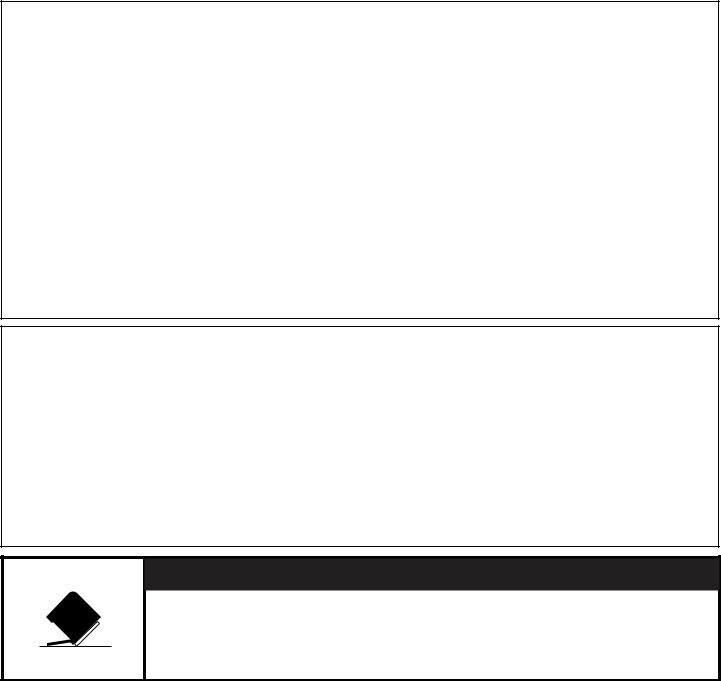
IMPORTANT SAFETY INSTRUCTIONS
WARNING: When using the dishwasher, follow basic precautions, including the following:
■Read all instructions before using the dishwasher.
■Use the dishwasher only for its intended function.
■Use only detergents or rinse agents recommended for use in a dishwasher, and keep them out of the reach of children.
■When loading items to be washed:
1)Locate sharp items so that they are not likely to damage the door seal; and
2)Load sharp knives with the handles up to reduce the risk of cut-type injuries.
■Do not wash plastic items unless they are marked “dishwasher safe” or the equivalent. For plastic items not so marked, check the manufacturer's recommendations.
■Do not touch the heating element during or immediately after use.
■Do not operate the dishwasher unless all enclosure panels are properly in place.
■Do not tamper with controls.
■Do not abuse, sit on, or stand on the door, lid, or dish racks of the dishwasher.
■To reduce the risk of injury, do not allow children to play in or on the dishwasher.
■Under certain conditions, hydrogen gas may be produced in a hot water system that has not been used for two weeks or more. HYDROGEN GAS IS EXPLOSIVE. If the hot water system has not been used for such a period, before using the dishwasher turn on all hot water faucets and let the water flow from each for several minutes. This will release any accumulated hydrogen gas. As the gas is flammable, do not smoke or use an open flame during this time.
■Remove the door or lid to the washing compartment when removing an old dishwasher from service or discarding it.
SAVE THESE INSTRUCTIONS
GROUNDING INSTRUCTIONS
■For a grounded, cord-connected dishwasher:
The dishwasher must be grounded. In the event of a malfunction or breakdown, grounding will reduce the risk of electric shock by providing a path of least resistance for electric current. The dishwasher is equipped with a cord having an equipment-grounding conductor and a grounding plug. The plug must be plugged into an appropriate outlet that is installed and grounded in accordance with all local codes and ordinances.
WARNING: Improper connection of the equipmentgrounding conductor can result in a risk of electric shock.
Check with a qualified electrician or service representative if you are in doubt whether the dishwasher is properly grounded. Do not modify the plug provided with the dishwasher; if it will not fit the outlet, have a proper outlet installed by a qualified electrician.
■For a permanently connected dishwasher:
The dishwasher must be connected to a grounded metal, permanent wiring system, or an equipment-grounding conductor must be run with the circuit conductors and connected to the equipment-grounding terminal or lead on the dishwasher.
SAVE THESE INSTRUCTIONS
 WARNING
WARNING
Tip Over Hazard
Do not use dishwasher until completely installed.
Do not push down on open door.
Doing so can result in serious injury or cuts.
2
Downloaded from www.Manualslib.com manuals search engine

1 Prepare and load dishwasher.
2 Add detergent for cleaning and rinse aid for drying.
Quick Steps
3 Select a cycle and option.
4 Start dishwasher.
NOTE: If the START/RESUME button is located on the top of door, push door firmly closed within 3 seconds of pressing START/RESUME.
Dishwasher Use
STEP 1
Prepare and Load the Dishwasher
IMPORTANT: Remove leftover food, bones, toothpicks and other hard items from the dishes. Remove labels from containers before washing.
Upper rack |
Lower rack |
■Make sure nothing keeps spray arm(s) from
spinning freely. It is important for the water spray to reach all soiled surfaces.
■Make sure that when the dishwasher door is closed no items are blocking the detergent dispenser.
■Items should be loaded with soiled surfaces facing down and inward to the spray as shown. This will improve cleaning and drying results.
■Avoid overlapping items like bowls or plates that may trap food.
■Place plastics, small plates and glasses in the upper rack. Wash only plastic items marked “dishwasher safe.”
■To avoid thumping/clattering noises during operation: Load dishes so they do not touch one another. Make sure lightweight load items are secured in the racks.
■When loading silverware, always place sharp items pointing down and avoid “nesting” as
shown.
STEP 2
Add Detergent
NOTE: If you do not plan to run a wash cycle soon, run a rinse cycle. Do not use detergent.
■Use automatic dishwasher detergent only. Add powder, liquid or tablet detergent just before starting a cycle.
■ Fresh automatic |
A |
|
|
dishwasher detergent |
|
||
|
|
||
results in better |
Hard Water |
Hard Water |
|
cleaning. Store tightly |
Soft Water |
Soft Water |
|
B |
|||
closed detergent |
C |
||
|
|||
container in a cool, dry |
|
PRE- |
|
MAIN WASH |
WASH |
place.
A. Cover latch
B. Main Wash section
C. Pre-Wash section
■The amount of detergent to use depends on:
How much soil remains on the items - Heavily soiled loads require more detergent.
The hardness of the water - If you use too little in hard water, dishes won't be clean. If you use too much in soft water, glassware will etch.
Soft to Medium Water (0-6 grains per U.S. gallon) [typical water softener water and some city water]
Medium to Hard Water (7-12 grains per U.S. gallon) [well water and some city water]
■Depending on your water hardness, fill the Main Wash section of the dispenser as shown. Fill the Pre-Wash section to the level shown, if needed.
NOTE: Fill amounts shown |
Hard Water |
|
|
are for standard powdered |
|
||
Soft Water |
Hard Water |
||
detergent. Follow |
Soft Water |
||
|
|||
instructions on the package |
Main Wash |
Pre-Wash |
|
when using other dishwasher |
|||
detergent. |
|
|
Add Rinse Aid
■Your dishwasher is designed to use rinse aid for good drying performance. Without rinse aid your dishes and dishwasher interior will have excessive moisture. The heat dry option will not perform as well without rinse aid.
3
Downloaded from www.Manualslib.com manuals search engine
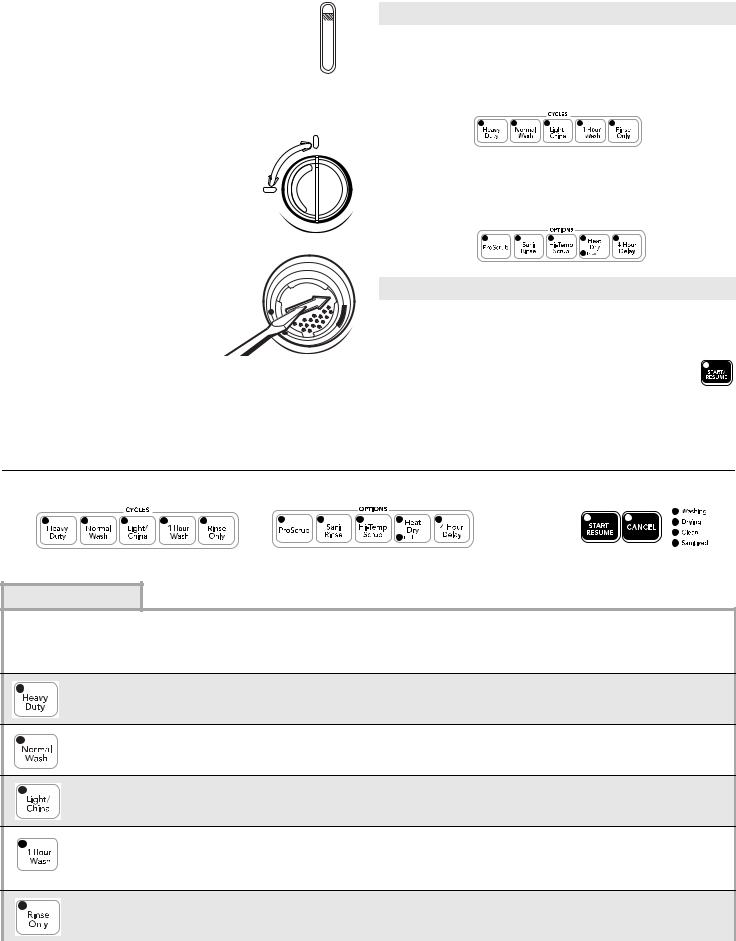
■ Rinse aid keeps water from forming droplets that can |
|
Full |
dry as spots or streaks. They also improve drying by |
|
|
allowing water to drain off of the dishes after the final |
|
|
rinse. |
|
|
■ Rinse aid helps to reduce excess moisture on the dish |
|
Add |
racks and interior of your dishwasher. |
|
|
|
|
■Check the rinse aid indicator. Add rinse aid when indicator drops to “Add” level.
■ To add rinse aid, turn the dispenser cap |
|
|
Lock |
|
|
|||
to “Refill” and lift off. Pour rinse aid into |
|
|
|
|
||||
|
|
|
|
|
|
|
|
|
the opening until the indicator level is at |
|
|
|
|
6 |
|
|
|
“Full.” Replace the dispenser cap and |
|
|
-- |
- |
543 |
|||
|
|
|
||||||
turn to “Lock.” Make sure cap is fully |
|
max |
fill |
|
|
|
|
|
Refill |
|
|
|
|
|
2 |
||
locked. |
- |
|
|
|
|
|
1 |
|
|
- |
|
|
|
|
|
|
|
|
|
- |
|
|
|
|
- |
|
|
|
- |
|
|
|
|
||
|
|
|
- |
|
|
|
- |
|
|
|
|
- |
- |
- |
- |
|
|
|
|
|
|
|
||||
STEP 3
Select a Cycle (cycles vary by model)
See “Cycle and Option Descriptions” charts in the following section.
Heavier cycles and options affect cycle length. Some cycles and options will take up to 3¹⁄ hours to complete.
Select Options (options vary by model)
See “Cycle and Option Descriptions” charts in the following section.
You can customize your cycles by pressing the options desired.
NOTE: For most water conditions, the factory setting of 2 will give good results. If you have hard water or notice rings or spots, try a higher setting. Turn the arrow adjuster inside the dispenser by either using your fingers or inserting a flat-blade screwdriver into the center of the arrow and turning.
¹⁄ turn to lock
|
- |
- |
6 |
5 |
4 |
|
|
|
- |
|
|
|
|
|
|
|
fill |
|
|
|
|
|
|
max |
|
|
|
|
3 |
||
|
|
|
|
|
|
2 |
|
|
|
|
|
|
|
|
1 |
|
|
|
|
|
|
- |
- |
|
|
|
|
|
|
|
|
|
|
|
|
- |
- |
|
|
|
|
|
|
|
|
|
|
STEP 4
Start or Resume a Cycle
■Run hot water at the sink nearest your dishwasher until the water is hot. Turn off water.
■ Push door firmly closed. The door latches automatically. Select the wash cycle and options desired OR press START/RESUME to repeat the same cycle and options as in the previous wash cycle.
■ You can add an item anytime before the main wash starts. Open the door slowly and add the item. Close the door firmly. Press START/RESUME.
Cycle and Option Descriptions
This information covers several different models. Your dishwasher may not have all of the cycles and options described.
CYCLE SELECTIONS
CYCLES DISH LOAD TYPES |
DESCRIPTIONS |
WASH TIME (HH:MM) |
|
|
|
|
|
|
|
Cycle |
Cycle + Options *Maximum |
|
|
Minimum |
Minimum |
Use for hard-to-clean, heavily soiled pots, pans, casseroles, and regular tableware.
During the wash, the wash action will |
1:55 |
2:25 |
3:23 |
repeatedly pause for several seconds. |
|
|
|
Use for loads with normal amounts of food soil.
The energy-usage label is based on this |
1:25 |
1:50 |
3:13 |
cycle. During the wash, the wash action will repeatedly pause for several seconds.
Use for lightly soiled items or china and crystal.
During the wash, the wash action will |
1:20 |
1:50 |
3:14 |
repeatedly pause for several seconds. |
|
|
|
When you need fast results, the 1 Hour Wash will clean your dishes using slightly more water and energy.
This cycle does not dry. For improved |
0:58 |
0:88 |
0:58 |
drying, select the Heated Dry option, adding ¹⁄ hour to the wash cycle.
Use for rinsing dishes, This cycle does not dry. 0:15 none none
|
glasses, and silverware that |
Do not use detergent. |
|
will not be washed right away. |
|
|
|
|
|
|
|
4
Downloaded from www.Manualslib.com manuals search engine
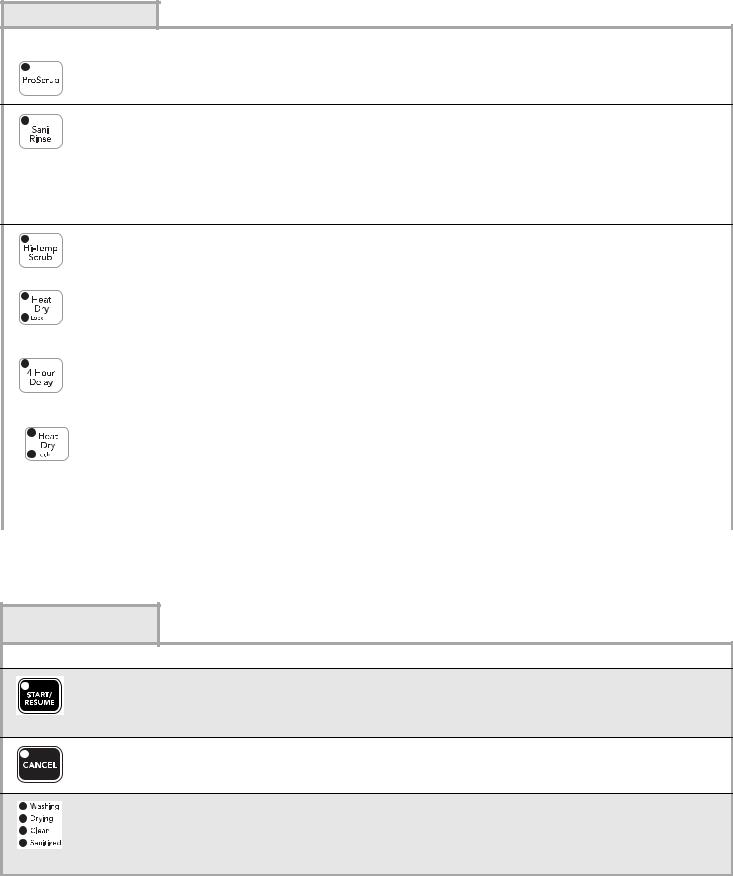
You can customize your cycle by selecting an option.
See option selections. If you change your mind, press the option again to turn off the option, or select a different option. You can change an option anytime before the selected option begins.
*Maximum wash times depend on water temperature, heavy soil condition, dish load size and options selected.
OPTION SELECTIONS
|
OPTIONS |
DISH LOAD TYPES |
DESCRIPTIONS |
USE WITH: |
||
|
|
|
|
|
|
|
|
|
|
|
Pans, casseroles, etc. with |
Activates the PROSCRUB® spray jets and provides |
Heavy Duty or Normal |
|
|
|
|
|||
|
|
|
|
tough food soil. |
intensified water spray to the back of the lower level rack. |
cycle |
|
|
|
|
|
May add heat and time to the cycle. |
|
|
|
|
|
|
|
|
To sanitize your dishes and glassware in accordance with NSF/ANSI Standard 184 for Residential Dishwashers.
Raises the water temperature in the final rinse to approximately 155°F (68°C). This high temperature rinse sanitizes your dishes and glassware in accordance with NSF/ANSI Standard 184 for Residential Dishwashers. Certified residential dishwashers are not intended for licensed food establishments.
The Sanitize or Sani Rinse option adds heat and time to the cycle.
Normal cycle. Heavy Duty cycle automatically uses Sani Rinse. Only these sanitization cycles have been designed to meet the NSF/ANSI requirements.
|
|
|
|
Loads containing tough, |
Increases the target water temperature during the wash |
Heavy Duty or Normal |
|
|
|
|
|||
|
|
|
|
baked-on food. |
portions of the cycle. |
cycles |
|
|
|
|
|
Adds heat, wash time and water to the cycle. |
|
|
|
|
|
|
|
|
|
|
|
|
|
|
|
|
|
|
|
For best drying results, dry |
Turn OFF when loads contain plastic dinnerware that may be |
All cycles, except Rinse |
|
|
|
|
dishes with heat. |
sensitive to high temperatures. |
Only. Automatic with all |
|
|
|
|
|
This option with the use of rinse aid will provide the best |
wash cycles unless you |
|
|
|
|
|
turn it off. |
|
|
|
|
|
|
drying performance. |
|
|
|
|
|
|
|
|
|
|
|
|
|
|
|
|
|
|
|
To run your dishwasher at |
Delays the start of a cycle up to 4 hours. |
All cycles, except Rinse |
|
|
|
|
|||
|
|
|
|
a later time or during off- |
Select a wash cycle and options. Press 4 Hour Delay. Press |
Only |
|
|
|
|
peak hours. |
|
|
|
|
|
|
START/RESUME. Close the door firmly. |
|
|
|
|
|
|
|
|
|
|
|
|
|
|
|
|
|
Control Lock To avoid unintended use of |
To turn on Lock, press and hold Heat Dry for at least |
Anytime |
|||
|
|
|
|
your dishwasher, or cycle |
4 seconds. |
|
|
|
|
|
and option changes during |
To turn off Lock, press and hold Heat Dry for at least |
|
|
|
|
|
a cycle. |
|
|
|
|
|
|
4 seconds. |
|
|
|
|
|
|
|
|
|
|
|
|
|
|
When Control Lock is lit, all buttons are disabled. If you press |
|
|
|
|
|
|
any pad while your dishwasher is locked, the light flashes |
|
|
|
|
|
|
3 times. The dishwasher door can be opened while the |
|
|
|
|
|
|
controls are locked. |
|
|
|
|
|
|
|
|
IMPORTANT: The sensor in your dishwasher monitors the soil level. Cycle time and/or water usage can vary as the sensor adjusts the cycle for the best wash performance. If the incoming water is less than the recommended temperature or food soils are heavy, the cycle will automatically compensate by adding time, heat and water as needed.
CONTROLS AND
CYCLE STATUS
CONTROL PURPOSE |
COMMENTS |
To start or resume a wash cycle
If the door is opened during a cycle or the power is interrupted, the START/RESUME indicator flashes. The cycle will not resume until the door is closed and START/RESUME is pressed.
NOTE: If the START/RESUME button is located on top of door, push door firmly closed within 3 seconds of pressing START/RESUME.
To cancel wash |
Close the door firmly. The dishwasher starts a 2-minute drain (if needed). Let the dishwasher |
cycle |
drain completely. |
To follow the progress of your dishwasher cycle
The Clean indicator glows when a cycle is finished.
If you select the Sani Rinse option, when the Sani Rinse cycle is finished, the Sanitized indicator glows. If your dishwasher did not properly sanitize your dishes, the light flashes at the end of the cycle. This can happen if the cycle is interrupted, or the water could not be heated to the required temperature. The light goes off when you open and close the door or press CANCEL.
5
Downloaded from www.Manualslib.com manuals search engine
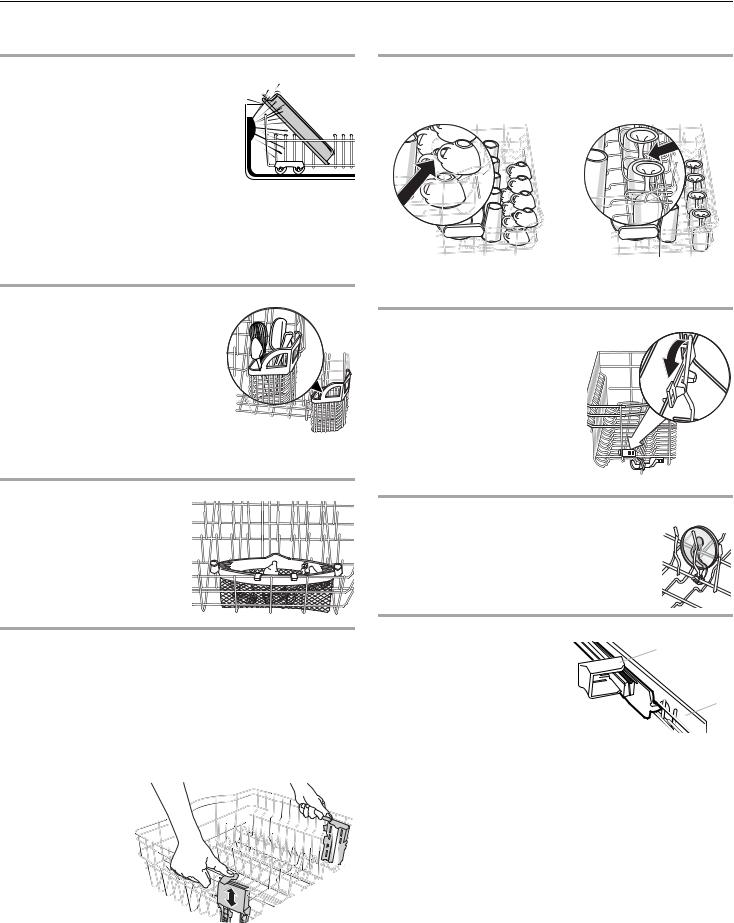
Dishwasher Features
Your KitchenAid dishwasher may have some or all of these features.
PROSCRUB® Wash Area |
SURE-HOLD® Cup and Stemware Holder |
The PROSCRUB® wash area is located at the back of the lower level rack.
NOTE: You must select the PROSCRUB® wash option to use this feature. Make sure items do not interfere with the water feed tube, spray arms, or PROSCRUB® spray jets.
■Load pans, casserole dishes, etc. in the back of the lower dish rack with the soiled surfaces facing the PROSCRUB® spray jets.
■Only one row of items may face the PROSCRUB® spray jets. Stacking, overlapping or nesting items will keep the PROSCRUB® spray jets from contacting all of the surfaces.
CULINARY CADDY® Utensil Basket
Use the utensil basket to hold specialty cooking utensils (serving spoons, spatulas, and similar items), or overflow silverware items.
The basket hangs on the bottom rack in the right-hand corner. Load the basket while it is on the bottom rack or remove the basket for loading on a counter or table.
NOTE: Spin the spray arms. Be sure items in the basket do not stop the rotation of the spray arms.
SURE-HOLD® Small Items Mesh Pouch
This pouch hangs on the front of the bottom rack. Use it to hold small items that could otherwise “fly” around inside the dishwasher during a cycle.
Adjustable 2-Position Mid Level Rack
After removing the culinary tool rack, you can raise or lower the mid level rack to fit tall items in either the mid level or bottom rack. Adjusters are located on each side of the mid level rack. Each adjuster has 2 preset positions. The high and low positions are marked on the adjuster.
IMPORTANT: If using the culinary tool baskets in the Down position, the mid level rack must also be in the lowest position.
To raise the rack, press both rack adjusters and lift the rack until it is in the Up position and level.
To lower the rack, press both rack adjusters and slide the rack back to its lower position.
NOTE: The mid level rack must be level.
Fold down the extra shelf on the left-hand or right-hand side of the mid level rack to hold additional cups, stemware or long items such as utensils and spatulas.
NOTE: Remove the culinary tool basket(s) when washing tall stemware or other tall items in the mid level rack.
FLEXI-FOLD DOWN™ Flexible Tines
The row of tines on the left-hand and right-hand sides of the mid-level rack can be adjusted to make room for a variety of dishes.
To adjust the fold-down tines:
1.Grasp the tip of the tine that is in the tine holder.
2.Gently push the tine out of the holder.
3. Lay the tines down, toward the center of the rack.
SURE-HOLD® Light Item Clips
The light item clips hold lightweight plastic items such as cups, lids, or bowls in place during washing.
To move a clip:
1. Pull the clip up and off the tine.
2. Reposition the clip on another tine.
Removable Mid Level and Culinary Tool Racks
The removable racks allow you to wash larger items such as stock pots, roasters, and cookie sheets in the lower level rack.
IMPORTANT: Remove dishes prior to removing the mid level rack from dishwasher.
To remove the rack:
1.To access track stops, pull the rack forward until it stops and clicks into place.

 A
A
 B
B
A.Track stop
B.Track
2.To open track stops, flip the track stop to the outside of the track.
3.After opening both track stops, slide front wheels up and out of the slot in track. Continue to pull rack forward in track and slide the back wheels up and out of the track.
4.Close track stops.
5.Slide rack tracks back into dishwasher.
6
Downloaded from www.Manualslib.com manuals search engine
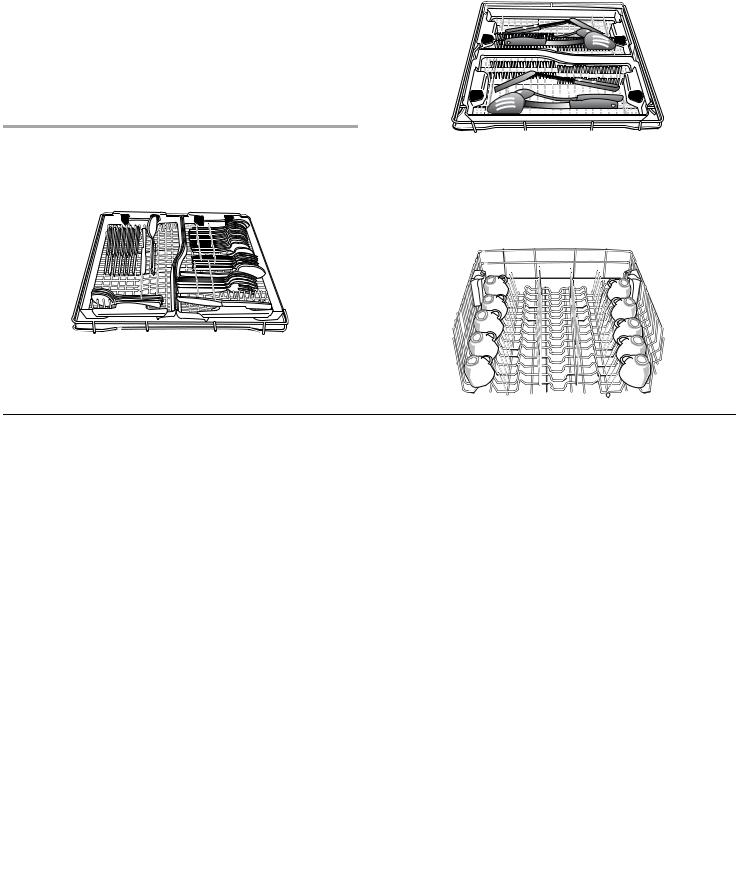
To replace the rack:
1.Gently pull rack tracks forward in dishwasher until they stop and click into place.
2.To open track stops, flip the track stop to the outside of the track.
3.Place the back rack rollers on each side of the rack into the track slot and roll the rack back into the tracks.
4.Insert front rack rollers on each side of the rack into the rack slots.
5.Close track stops on both sides of rack and slide rack back into dishwasher.
Culinary Tool Rack
The culinary tool rack is designed with 2 movable baskets to hold extra silverware, knives and cooking utensils.
Install the baskets in this up position when you have extra silverware and flatware to wash.
Up position
Install the baskets in this down position when you have extra silverware, knives, or utensils requiring more room to wash.
IMPORTANT: When you are using the culinary tool baskets in the down position, the mid level rack must also be in the lowest position.
Down position
Remove the front basket in the down position, when you are using the cup shelves or other tall items in the mid level rack for more room.
Filtration System
Your dishwasher has the latest technology in dishwasher filtration. This triple filtration system minimizes sound and optimizes water and energy conservation while providing superior cleaning performance. Throughout the life of your dishwasher, the filter will require maintenance to sustain peak cleaning performance.
The triple filter system consists of 2 parts, an upper filter assembly and a lower filter.
■The upper filter assembly keeps oversized items and foreign objects, along with very fine food particles, out of the pump.
■The lower filter keeps food from being recirculated onto your dishware.
The filters may need to be cleaned when: |
Locating |
Tabs |
■Visible objects or soils are on the Upper Filter Assembly.
■There is degradation in cleaning performance (that is, soils still present on dishes).
■Dishes feel gritty to the touch.
It is very easy to remove and maintain the filters. The chart below shows the recommended cleaning frequency.
SH DOWN & TU |
RN |
PU |
|
|
|
|
K |
|
|
|
|
|
O |
C |
L |
|
|
L |
|
|
O |
|
|
|
|
|
C |
|
N |
|
|
|
Upper Filter |
K |
U |
|
|
|
|
|
|
|
||
|
|
|
|
|
|
Assembly
Lower Filter
RECOMMENDED TIME INTERVAL TO CLEAN YOUR FILTER
Number of Loads |
If you wash |
If you scrape and rinse |
If you only scrape |
If you do not scrape or rinse |
Per Week |
before loading |
before loading |
before loading* |
before loading |
|
|
|
|
|
1-3 |
Once per year |
Once per year |
Twice per year |
Every two months |
|
|
|
|
|
4-7 |
Once per year |
Once per year |
Twice per year |
Once per month |
|
|
|
|
|
8-12 |
Once per year |
Twice per year |
Every three months |
Every two weeks |
|
|
|
|
|
13-14 |
Once per year |
Twice per year |
Every three months |
Once per week |
|
|
|
|
|
*Manufacturer's recommendation: This practice will conserve the water and energy that you would have used to prepare your dishes. This will also save you time and effort.
7
Downloaded from www.Manualslib.com manuals search engine
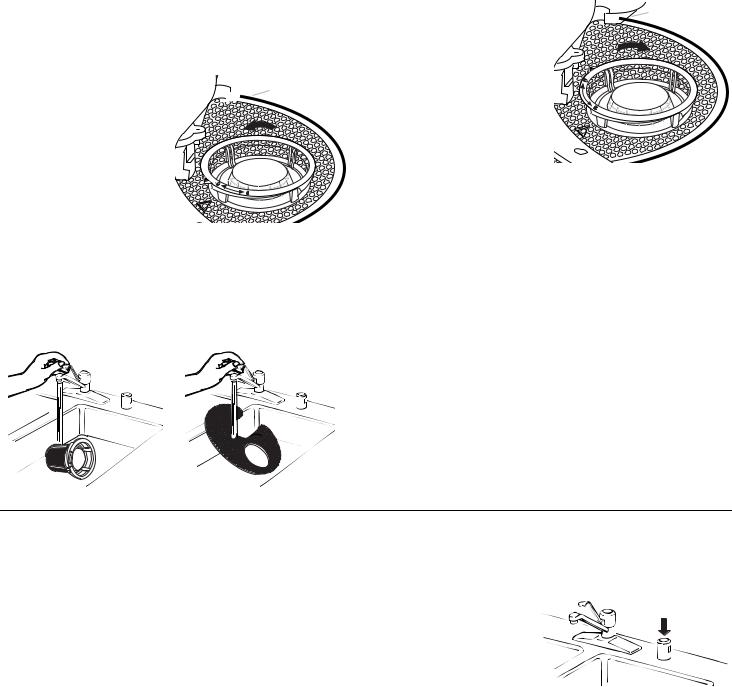
Very Hard Water
If you have hard water (above 15 grains), clean your filter at least once per month. Building up of white residue on your dishwasher indicates hard water. For tips on removing spots and stains, see “Troubleshooting” section.
Filter Removal Instructions
1.Turn the Upper Filter Assembly ¼ turn counterclockwise and lift out.
2.Grasp the Lower Filter in the circular opening, lift slightly, and pull forward to remove.
3.Clean the filters as shown
below.
 Locating tab
Locating tab
US |
H |
DO |
|
P |
|
WN |
|
|
|
|
& |
|
|
|
T |
|
|
|
U |
|
|
|
R |
|
|
|
N |
L |
|
O |
|
C |
|
K |
|
|
K |
C |
|
UNLO |
|
To remove Upper Filter Assembly
Cleaning Instructions
IMPORTANT: Do not use wire brush, scouring pad, etc. as they may damage the filters.
Rinse filter under running water until most soils are removed. If you have hard-to-remove soils or calcium deposits from hard water, a soft brush may be required.
|
|
L |
|
|
|
|
|
C |
O |
|
|
|
|
K |
|
|
P |
|||
|
|
|
|
U |
||
|
|
|
|
|
S |
|
|
|
|
|
|
|
H |
|
|
|
|
|
|
D |
|
|
|
|
|
|
O |
|
|
|
|
|
|
W |
|
|
|
|
|
|
N |
|
|
|
|
|
T |
& |
U |
|
N |
R |
U |
|
|
N |
|
|
|
|
||
|
L |
|
|
|
|
|
|
|
OCK |
|
|
|
|
Filter Reinstallation Instructions
1.Noting the previous illustrations, place the Lower Filter under the Locating Tabs in the bottom of the dishwasher so the round opening for the Upper Filter Assembly lines up with the round opening in the bottom of the tub.
 Locating tab
Locating tab
L |
|
PU |
S |
H |
|
|
O |
|
|
|
|
|
|
C |
|
|
|
D |
|
|
|
|
|
O |
|
|
|
K |
|
|
|
W |
|
|
|
|
|
N |
|||
|
|
|
|
|
& |
|
|
|
|
|
|
U |
T |
|
|
|
|
R |
|
|
|
|
|
|
|
|
|
|
|
|
|
N |
|
|
U |
|
|
|
|
|
|
N |
|
|
|
|
|
|
|
LO |
|
|
|
|
|
|
CK |
|
|
|
|
|
To replace Upper Filter Assembly
2.Insert the Upper Filter Assembly into the circular opening in the Lower Filter.
3.Slowly rotate the filter clockwise until it drops into place. Continue to rotate until the filter is locked into place. If the filter is not fully seated (still turns freely), continue to turn the filter clockwise until it drops and locks into place.
NOTE: The Upper Filter Assembly arrow does not have to align with the arrow in the Lower Filter as long as the filter is locked.
IMPORTANT: To avoid damage to dishwasher, do not operate your dishwasher without the filters properly installed. Be sure the Lower Filter is securely in place and the Upper Filter Assembly is locked into place. If the Upper Filter Assembly turns freely, it is not locked into place.
Dishwasher Care
Cleaning the Dishwasher
Clean the exterior of the dishwasher with a soft, damp cloth and mild detergent. If your dishwasher has a stainless steel exterior, a stainless steel cleaner is recommended.
Clean the interior of the dishwasher, with a paste of powdered dishwasher detergent and water or use liquid dishwasher detergent on a damp sponge to clean the cooled-down interior.
A white vinegar rinse may remove white spots and film. Vinegar is an acid, and using it too often could damage your dishwasher.
Put 2 cups (500 mL) white vinegar in a glass or dishwasher-safe measuring cup on the bottom rack. Run the dishwasher through a complete washing cycle using an air-dry or an energy-saving dry option. Do not use detergent. Vinegar will mix with the wash water.
If you have a drain air gap, check and clean it if the dishwasher isn't draining well.
Storing the Dishwasher
If you will not be using the dishwasher during the summer months, turn off the water and power supply to the dishwasher. In the winter, if the dishwasher could be exposed to near freezing temperatures or is left in a seasonal dwelling such as a second home or vacation home, avoid water damage by having your dishwasher winterized by authorized service personnel.
8
Downloaded from www.Manualslib.com manuals search engine
